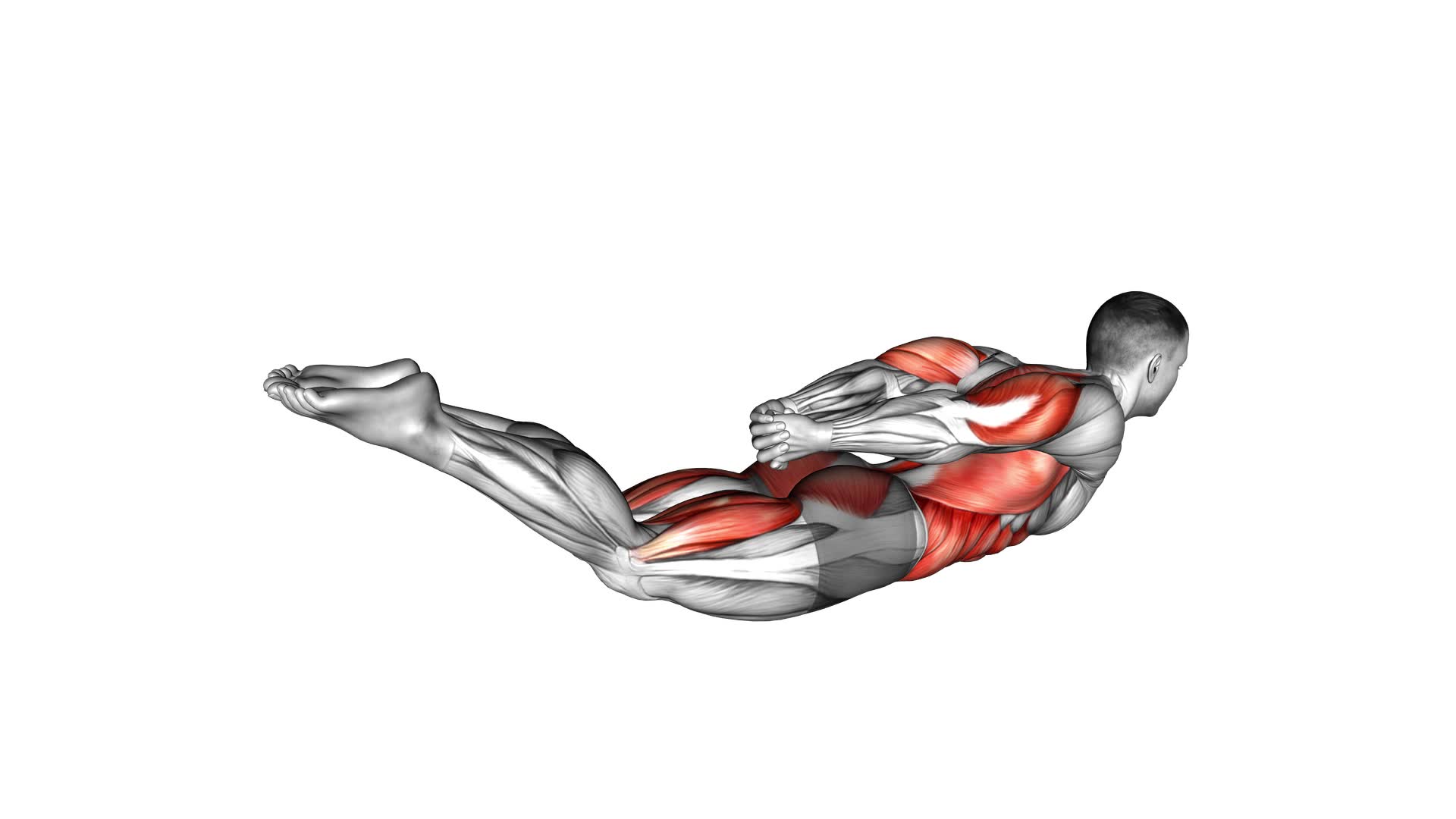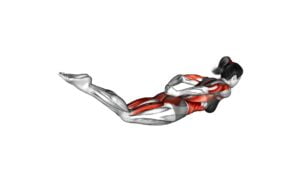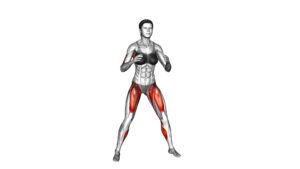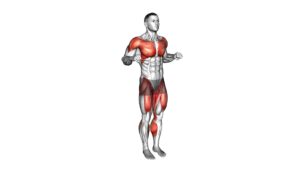Lying Double Leg Kick (male) – Video Exercise Guide & Tips

Are you ready to take your leg workouts to the next level? Look no further than the Lying Double Leg Kick.
Watch This Exercise Video
This exercise is specifically designed for men, targeting your lower body muscles and improving overall strength and flexibility.
In just a few minutes a day, you can achieve incredible results. Follow our video exercise guide and tips to ensure proper form and technique.
Get ready to kick your fitness goals into high gear!
Key Takeaways
- The Lying Double Leg Kick targets lower body muscles and improves strength and flexibility.
- It enhances posture and stability, alleviates lower back pain, and prevents injuries.
- Variations of the exercise include using a stability ball, adding a resistance band, and increasing resistance and challenge.
- Proper form and technique involve lying face down on a mat, kicking the legs up and down while maintaining control and engaging the core.
Benefits of the Lying Double Leg Kick
The lying double leg kick offers a range of benefits for you, including improved core strength and flexibility. This exercise primarily targets your glutes, hamstrings, and lower back muscles. By strengthening these areas, you can improve your posture, stability, and overall athletic performance. Additionally, the lying double leg kick can help to alleviate lower back pain and prevent future injuries.
One of the variations of this exercise involves using a stability ball. By placing the stability ball between your ankles, you can increase the resistance and challenge your muscles even further. Another variation is to add a resistance band around your ankles to provide additional tension. This variation is especially effective for targeting your outer hip muscles.
Proper form and technique for the lying double leg kick are crucial to ensure you maximize the benefits and minimize the risk of injury. To perform this exercise correctly, start by lying face down on a mat with your legs extended behind you. Bend your knees and lift your legs slightly off the ground. From here, simultaneously kick your legs up and down, maintaining control and engaging your core throughout the movement. Remember to breathe consistently and avoid any jerky or sudden motions.
Proper Form and Technique for the Exercise
To perform the lying double leg kick with proper form and technique, it's important to focus on engaging your core throughout the exercise. Keep your abdominal muscles tight and your back flat on the ground to ensure stability and prevent strain.
Additionally, remember to breathe deeply and exhale as you kick your legs up and inhale as you lower them back down, allowing for proper oxygen flow and muscle activation.
Core Engagement Tips
Achieving optimal core engagement is crucial for performing the Lying Double Leg Kick exercise effectively and safely. To ensure proper core stability during this exercise, focus on abdominal activation.
Start by lying face down on the mat, with your arms extended overhead and your legs straight. As you lift your chest and legs off the ground, engage your core by pulling your belly button towards your spine. This will activate your deep abdominal muscles and provide a stable base for the exercise.
Throughout the movement, maintain this core engagement to prevent excessive strain on your lower back. Remember to breathe steadily and avoid holding your breath, as it can hinder your core activation.
Breathing During Exercise
To maintain proper form and technique during the Lying Double Leg Kick exercise, you should focus on coordinating your breath with the movement. Breathing techniques play a crucial role in any exercise routine, including the Lying Double Leg Kick.
Proper breathing ensures that your muscles receive adequate oxygen and helps you maintain control and stability throughout the exercise. As you perform the leg kick, exhale deeply and engage your core muscles. This exhale should coincide with the effort of the movement. Inhale as you return to the starting position.
Modifications for Beginners and Advanced Practitioners
Now let's talk about the modifications you can make for the Lying Double Leg Kick, whether you're a beginner or an advanced practitioner.
For beginners, you can start by performing the exercise with smaller movements and less intensity to gradually build strength and flexibility.
Advanced practitioners can challenge themselves by adding resistance bands or using a stability ball to increase the difficulty of the exercise.
Beginner Modifications for Lying Double Leg Kick
When starting out, you can modify the lying double leg kick exercise to make it more accessible for beginners and advanced practitioners.
For beginners, it's important to focus on building strength and flexibility gradually. Start by keeping your legs slightly bent instead of fully extended. This will reduce strain on your lower back and make the exercise more manageable.
As you become more comfortable, you can gradually straighten your legs. Another modification for beginners is to keep your head down throughout the exercise, instead of lifting it up. This will help you maintain proper alignment and prevent unnecessary strain on your neck.
By making these modifications, you can ease into the lying double leg kick and gradually progress to the full exercise.
Now, let's move on to advanced modifications for the lying double leg kick.
Advanced Modifications for Lying Double Leg Kick
To progress the lying double leg kick exercise, advanced practitioners can incorporate additional challenges and variations. These advanced modifications are designed to further strengthen the core and increase the difficulty of the exercise.
One variation is to add ankle weights to increase resistance and intensify the workout.
Another option is to perform the exercise on a stability ball, which adds an element of instability, requiring the core muscles to work harder to maintain balance.
Advanced practitioners can also try performing the exercise with their arms extended overhead, adding an upper body component to the movement.
These variations and progressions provide advanced core strengthening techniques that will challenge even the fittest individuals. By incorporating these modifications, you can continue to push your limits and achieve greater strength and stability.
Now let's move on to the next section to learn about common mistakes to avoid during the exercise.
Common Mistakes to Avoid During the Exercise
During the exercise, be mindful of the common mistakes to avoid. Proper form is essential to ensure you get the most out of the lying double leg kick. Here are some common mistakes to watch out for:
- Arching your back excessively: Avoid overarching your back during the exercise as it can strain your lower back. Keep your core engaged and maintain a neutral spine throughout.
- Raising your shoulders: Keep your shoulders relaxed and avoid hunching them up towards your ears. Maintain a tall posture to engage your core effectively.
- Flaring your ribs: Be cautious not to flare your ribs outwards, as it can lead to improper engagement of your abdominal muscles. Instead, focus on keeping your ribs down and maintain a stable core.
- Rushing through the movement: Take your time with each rep and avoid rushing through the exercise. Pay attention to the controlled movement, emphasizing the squeeze of your glutes and hamstrings.
By avoiding these common mistakes, you can perform the lying double leg kick with proper form, maximizing its effectiveness.
Now let's move on to the next section, where we'll discuss tips for maximizing the effectiveness of the lying double leg kick.
Tips for Maximizing the Effectiveness of the Lying Double Leg Kick
To maximize the effectiveness of the lying double leg kick, focus on maintaining proper form and engaging your muscles throughout the exercise. Proper form is crucial to ensure that you're targeting the right muscles and avoiding unnecessary strain on your body. As you perform the exercise, pay attention to the alignment of your spine and pelvis. Keep your core engaged and your lower back pressed into the mat.
Another way to maximize the effectiveness of the lying double leg kick is by working on your flexibility. This exercise primarily targets the hamstrings and glutes, so it's important to have adequate flexibility in these areas. Regular stretching exercises, such as forward folds and hamstring stretches, can help improve your flexibility and enhance the benefits of the exercise.
Additionally, you can vary the lying double leg kick to target different muscle groups. For example, by adding ankle weights or resistance bands, you can increase the intensity and focus on strengthening your leg muscles even more. Alternatively, you can perform the exercise with a stability ball or Pilates ring to engage your core and challenge your balance.
Remember to listen to your body and start with the variations that are suitable for your fitness level. Gradually progress as you become more comfortable and stronger. By incorporating these tips and variations, you can maximize the effectiveness of the lying double leg kick and achieve better results in your workout routine.
Sample Workout Routine Incorporating the Lying Double Leg Kick
To maximize the effectiveness of your workout routine, incorporate the lying double leg kick into your exercises. This exercise targets multiple muscle groups and can be done in various workout variations to keep your routine challenging and engaging.
Here are some sample workout variations that incorporate the lying double leg kick:
- Traditional lying double leg kick: Lie face down on a mat, lift your legs off the ground, and kick them up and down while keeping your core engaged. This targets your glutes, hamstrings, and lower back.
- Lying double leg kick with resistance band: Attach a resistance band around your ankles and perform the same kicking motion. The resistance band adds extra tension, working your leg muscles even harder.
- Lying double leg kick with stability ball: Place a stability ball between your legs and squeeze it as you perform the kicking motion. This engages your inner thighs and abdominal muscles while working your legs.
- Lying double leg kick with dumbbells: Hold a pair of dumbbells in your hands and perform the kicking motion. The added weight challenges your arm muscles, giving you a full-body workout.
Frequently Asked Questions
How Many Calories Does the Lying Double Leg Kick Burn?
The lying double leg kick is an effective exercise for burning calories. It targets your lower body muscles and can help you achieve your weight loss goals.
There are variations and modifications you can try to increase the calorie burn and make the exercise more challenging.
Can the Lying Double Leg Kick Help With Lower Back Pain?
The lying double leg kick can be a helpful exercise for relieving lower back pain. By incorporating modifications, such as using a pillow or rolled towel for support, you can tailor the exercise to your comfort level.
This exercise focuses on stretching the muscles in your lower back, which can help alleviate tension and reduce pain. Stretching is a beneficial practice for managing lower back pain, and the lying double leg kick is a great option to incorporate into your routine.
Is the Lying Double Leg Kick Suitable for Pregnant Women?
The lying double leg kick is a great exercise for strengthening the lower back and glute muscles. Pregnant women should avoid lying flat on their stomach and instead perform the exercise on their side or with the support of a pregnancy pillow. This modification ensures safety and comfort during pregnancy. Additionally, the lying double leg kick can be beneficial for strengthening the pelvic floor, which is important during pregnancy.
How Often Should the Lying Double Leg Kick Be Performed to See Results?
To see results from the lying double leg kick, you need to perform it regularly. The frequency of this exercise depends on your fitness level and goals. However, it's generally recommended to do it 2-3 times a week.
Can the Lying Double Leg Kick Improve Flexibility in the Hamstrings?
To improve hamstring flexibility, the lying double leg kick can be beneficial. By performing this exercise regularly, you can stretch and strengthen your hamstrings, leading to increased flexibility.
The lying double leg kick targets the muscles in your hamstrings, helping them become more flexible over time. Incorporating this exercise into your routine can provide long-term benefits for your hamstring flexibility.
Conclusion
In conclusion, the lying double leg kick is a beneficial exercise for both beginners and advanced practitioners. By properly engaging the core muscles and maintaining the correct form, this exercise can help improve lower body strength and flexibility.
It's important to avoid common mistakes and follow the proper modifications to prevent injury. Incorporating the lying double leg kick into a well-rounded workout routine can maximize its effectiveness and contribute to overall fitness and wellness.

Author
Years ago, the spark of my life’s passion ignited in my mind the moment I stepped into the local gym for the first time. The inaugural bead of perspiration, the initial endeavor, the very first surge of endorphins, and a sense of pride that washed over me post-workout marked the beginning of my deep-seated interest in strength sports, fitness, and sports nutrition. This very curiosity blossomed rapidly into a profound fascination, propelling me to earn a Master’s degree in Physical Education from the Academy of Physical Education in Krakow, followed by a Sports Manager diploma from the Jagiellonian University. My journey of growth led me to gain more specialized qualifications, such as being a certified personal trainer with a focus on sports dietetics, a lifeguard, and an instructor for wellness and corrective gymnastics. Theoretical knowledge paired seamlessly with practical experience, reinforcing my belief that the transformation of individuals under my guidance was also a reflection of my personal growth. This belief holds true even today. Each day, I strive to push the boundaries and explore new realms. These realms gently elevate me to greater heights. The unique combination of passion for my field and the continuous quest for growth fuels my drive to break new ground.







